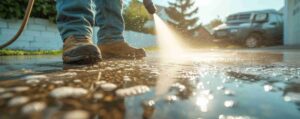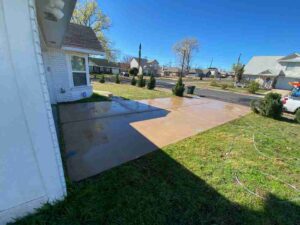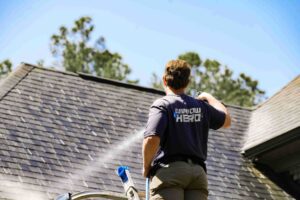How to Use a Pressure Washer
At any given point in property ownership, you’ll need to clean your exterior surfaces. Knowing how to use a pressure washer, what tools you’ll need, and how to tackle your project safely are the most important things you can do to power wash your house without damaging it or injuring yourself.
Below we cover the specifics on how you can safely use a pressure washer to clean the exterior surfaces of your home as well as what surfaces you should just avoid altogether. Here’s a preview of what you’ll be reading about in our guide on how to power wash:
Pressure Washing Steps
- Prepare the machine and area you’ll be working in so that it’s free of obstacles.
- Make sure your water source is properly attached and that there aren’t leaks.
- Check the pressure and make adjustments as needed, such as switching nozzles.
- Start your project; use our tips for effective and efficient cleaning.
- Make sure to turn off your machine and water when you’re done. (You’d be surprised how often this is forgotten)
- Detach your pressure washer from the water source before moving the machine.
Keep reading for our information on safety, tools you’ll need, an in-depth look at these steps, and our guide on what surfaces you should and shouldn’t use a pressure washer to clean.
Tools & Supplies You’ll Need
While a new pressure washer will likely come with some supplies, it won’t have all the accessories you need to safely clean your exterior. Before you start your pressure washing project, it’s important to know what tools you need beyond the machine—and even if you have the right pressure washer for the job—plus what detergents might work best.
Protective Gear
With pressure washers in particular it’s important for the handler and those who might be working around the area to wear protection and be vigilant. Along with purchasing or renting the right pressure washer and using the correct nozzles (we’ll talk about that more below) it’s also important to make sure you stay safe with eye protection, ear protection in the case of gas pressure washers, and wear long-sleeved jeans and shirts to prevent lacerations from the water should you have an accident.
DO NOT use a pressure washer while working with a ladder. While it may be tempting for hard-to-reach areas, pressure washers exert a lot of force. Working on a ladder always comes with the risk of injury, and that risk increases when using a pressure washer.
Selecting The Right Pressure Washer
There are two types of pressure washers and each has its own attributes. Before strapping on your protective gear, it’s important to make sure you’ve got the right equipment for the job.
- Electric pressure washers.
These pressure washers are best for lighter-duty jobs, like cars or outdoor furniture. They don’t typically have a PSI higher than 1,400, which makes them safer compared to their gas counterparts, plus they are quieter and more lightweight. - Gas pressure washers.
These pressure washers, on the other hand, can deliver more force for bigger jobs, like prepping a home for painting. They typically exceed 3,000 PSI and are frequently used by professionals. Like other pressure washers, chemicals can be added for more effective cleaning.
Choosing Nozzles for the Job
More powerful pressure washers typically have more options when it comes to nozzles. This is because certain jobs require certain fan patterns and force and, having a variety of nozzles at your disposal makes it easier and more efficient to clean an area. Here are the five most common sizes and when you should use them:
Pressure Washer Nozzle Sizes & Uses
| Red | Yellow | Green | White | Black |
|---|---|---|---|---|
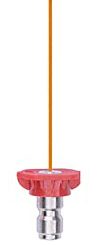 |
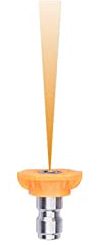 |
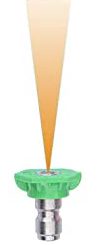 |
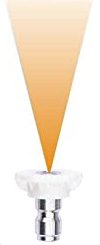 |
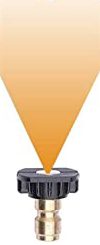 |
| 0-degree | 15-degree | 25-degree | 40-degree | 65-degree |
| Perfect for particularly hard to remove particles and debris |
Perfect for stripping an area, such as a deck or exterior, for repainting |
Perfect for cleaning dirt from areas like a driveway |
Perfect for more delicate areas such as near windows or light fixtures |
Perfect for soft wash applications and smaller projects |
Detergents You Might Use
Very often we recommend soft washing rather than pressure washing, and for good reason. Many surfaces are delicate and do better with detergents and chemicals over sheer force. Explore the chemicals used in a soft wash to learn more about your options and how you can clean your exterior with significantly less risk of damaging it.
1. Prepare Your Area & Machine
Before you begin any cleaning project, it’s important to not only learn how to use a pressure washer, but also prepare the area and machine. Here are our seven essential tips for pressure washing prep, but basically it comes down to picking up the area to remove possible hazards and to keep loved ones out of the area.
When it comes to preparing your machine, you’ll want to:
- If you’re using a chemical, fill the detergent reservoir prior to powering the machine up.
- Insert the right nozzle into the spray wand by retracting the collar, pushing the tip in as far as it’ll go, and then releasing the collar. Make sure it’s locked in place by pulling on it and feeling for any movement.
- While this seems like a step no one should miss, it’s easy to get caught up in the task of getting ready to pressure wash your home. Make sure that your gas pressure washer is fueled up, or that your electric pressure washer is plugged into a grounded outlet.
2. Attach to Water Source
Once your area is ready and the nozzle is applied, you’ll be ready to connect the water. Make sure the hose is connected to your home and then double check the connections between your faucet, the hose, and your pressure washer to ensure that everything fits appropriately.
➡️Pro Tip: Your garden hose needs to provide the right amount of pressure. To test this, simply fill a 5-gallon bucket. If it takes more than two minutes, you won’t have enough power to wash your home and will need professional pressure washing services.
Lastly, release air pressure by slowly squeezing the trigger and set your spray to off or low to prevent kickback once you turn on the water. Once you do turn on the water, you should be ready to move onto the next step.
3. Check PSI and Make Adjustments
With your wand pointed at the ground, check to make sure that there aren’t any issues or leaks. Leaks in the water hose should be evident, so examine the machine and connected parts carefully.
Squeeze the trigger to ensure that there isn’t any excess air in the wand or water line. Now that you’re able to see the pressure produced by the nozzle you’ve selected, make sure that it’s the right one for the job and if necessary, turn the machine off and go back to step one to change out your nozzle.
4. Start Cleaning
Once everything is in good working order, it’s time to actually start cleaning. Keep your safety in mind as well as that of others by avoiding horseplay while using the pressure washer. It’s important to make sure that you have a good handle on the washer wand at all times.
➡️Pro Tip: Do you know what you should and shouldn’t be pressure washing?
Our article goes over a list of exterior surfaces that are safe to use a pressure washer on, ones that can’t handle higher PSIs, and areas of the home that you absolutely shouldn’t use a pressure washer on.
Our Tips for Effective Pressure Washing
- Avoid openings, gaps, and electrical. To prevent damage to your home or create a serious safety issue, avoid electrical outlets, fixtures, windows, doors, and gaps. It’s best to cover these areas if possible.
- Work in smaller sections. This allows you to do a more thorough cleaning without worrying as much about dried detergents or streaks.
- When applying detergent, let it sit. Don’t let detergent dry on your surfaces, but particularly for stubborn stains it’s good to let it sit for a few minutes. Rewet as necessary, and work in the shade if possible. Also, apply it at the bottom and move upwards.
- Change nozzles as necessary. When using a detergent, it’s best to use a wide stream, like the black 60-degree one, and then switch to a narrower one for rinsing.
- Rinse multiple times. Your first rinse should be farther away from the surface, about 18 or 20 inches, and should start at the bottom going up. The second should be closer—but not enough to cause damage—and start at the top.
5. Once Finished, Turn Off Machine
Turning a pressure washer off isn’t as simple as flipping a light switch. To safely turn it off, you’ll release the trigger and turn on the safety lock. The safety lock is important as it can help prevent any accidental spraying or start-ups that could cause injury to yourself or damage to your property.
Also, be sure that you turn off the water source. Pressure builds up between the hose and machine; disconnecting your pressure washer from the hose without first relieving that pressure could result in injury or damage.
6. Detach from Water Source & Store Equipment
Once the machine is off and water is no longer going to the pressure washer, it’s safe to disconnect everything and store your water hose and machine. Be sure to store it in a dry, indoor area or, if you’ve rented a pressure washer, return it to the store.
Tips for Your Pressure Washing Project
Here are some general tips that might make your pressure washing project easier before, during, and after completion.
- Stay away from power lines and electricity when using a pressure washer. Beyond the power cord (in the case of electrical machines) you should maintain at least 6 feet between you and power lines at all times.
- For siding, stay at least four feet away to avoid damage. If build-up proves to be particularly difficult, it’s best to utilize soft wash methods.
- Be sure to use a pressure washer on a flat surface, such as a deck, rather than uneven terrain. Also, make sure the area is clear of obstacles.
- Keep in mind that a wider spray cleans a larger surface area and with less pressure—this is why a 60-degree nozzle is ideal for applying detergents—and narrower streams clean a smaller area but exert more force for stubborn stains.
The Do’s and Don’ts of Pressure Washing
When it comes to pressure washing your home, you may not even know where to begin—there could be dirt buildup on your siding, grime stains on your patio, and algae growth in the cracks of your driveway. But how do you take the next step in getting rid of it all? Check out our list of do’s and don’ts that you need to know before you tackle a pressure washing job yourself.
You CAN Pressure Wash Your Home’s Exterior
There’s a big but, though, and it frequently makes getting your home professionally pressure washed a more attractive option.
We recommend a soft wash process rather than pressure washing for your siding. Soft washing is a low-pressure, high-quality wash that removes all of the buildup and debris without damaging your siding.
This method is safe to use on a variety of siding types like vinyl, stucco, Hardiplank, and painted wood. Plus, the solution we use not only removes unwanted mildew and stains, but prevents it from coming back too soon as well. Lastly, if you’re noticing algae gathering on your roof too, be sure to read our blog article on how to get rid of it.
But, NOT if it’s an Older Brick Home
Most newer brick surfaces can safely be cleaned with a pressure washer. However, old brick buildings made with mortar may crumble under the pressure of a power cleaner so you should never have them cleaned this way. A soft wash might be safe, but it’s better to leave homes that need a more delicate touch to professionals rather than risk destroying the bricks.
You CAN Pressure Wash Your Deck & Patio
Many people love to maintain a beautiful deck or patio for outdoor entertainment, and it can really add value to your home! We recommend pressure washing your deck in the late spring after pollen and mildew have had a chance to settle and accumulate. Additionally, decks and patios must be pressure washed using a soft wash method to ensure proper cleaning and to prevent damages. If you have a deck or patio made of paver stones, be sure to check out our blog article on how to clean them for more information. Or, read this article that covers other simple ways you can refresh your outdoor space.
But, NOT if it’s Stained Wood or Painted Surfaces
While some stained wood surfaces can be safely cleaned with a pressure cleaner, most power washers will strip the stain from the wood. If you don’t want to re-stain wood, don’t clean it with pressured water.
Additionally, paint can be blasted off a surface when using a pressure washer. In fact, they are often used for this purpose when you’re ready to repaint and want to quickly remove the old paint.
Keep in mind that if you do want to remove paint with a pressure washer, you should never do so when dealing with lead paint. This can throw lead particles into the air which is dangerous.
You CAN Pressure Wash Your Driveway & Sidewalks
Driveways and sidewalks are prone to staining caused by the elements. Worse yet, they can become cracked and chipped due to freezing temperatures in the winter, giving easy access to unwanted plant and fungi growth.
Unlike the surfaces above, concrete is more or less safe for pressure washing because it can handle a hardy blast without risking damage. Ideally, pressure washing the driveway is done using a hard wash method, strong enough to remove stubborn contaminants.
Maintaining both of these areas can really enhance or distract from the overall curb appeal of your home, so make reminders to do it annually or let the professionals keep track of it for you—that’s just one of the many benefits of hiring a professional.
Areas You Absolutely Should NEVER Pressure Wash
While there may be flexibility with certain areas of the home as far as pressure washing goes, there are a few areas that you should never try to pressure wash yourself. In some cases, no one should. In other situations, the risk is too great and can cause damage, injury, or voiding home warranties that end up being costly.
Never pressure wash these areas:
Your Asphalt Roof
Asphalt shingles are actually made of a mixture of asphalt and other materials. Although it can withstand heavy rain, high-pressured water can remove the granules that help make your roof waterproof.
Electrical Boxes and Air Conditioners
Your outdoor electrical boxes and air conditioning units are designed to withstand rain. However, pressured water can be forced into small cracks which can damage the interior components. The air conditioner’s filter should also only ever be washed gently with a slow flow of water. This is something you can easily do yourself in a sink using a mild detergent and brush.
Windows
While it is important to keep windows clean, doing so with a pressure washer could end up breaking them which would do a lot more harm than good. Even if the glass can withstand the pressure, the water can be forced through your window seal which will either get into your home or possibly damage the seal.
Automotive Engines
Or any engine, for that matter. Although keeping your car engine clean is a great way to keep it running for longer, you never want to do this with a pressure washer. As with air conditioners, high pressured water can get into interior components which will wreak havoc on them.
Most experts also recommend avoiding using a pressure washer on the outside of vehicles as well since this can chip the paint or even cause dents.
Now that you know more about how to use a pressure washer and what all that entails, consider this. Buying and/or renting the equipment can be expensive, it’s a time-consuming project, and there’s a reasonably good chance that you might get hurt or your property damaged. Instead of investing more than just your money into a DIY project, consider simply paying professionals to take care of your home on a schedule. No hassle, no work for you.
Frequently asked questions about how to use a pressure washer
There are a lot of questions surrounding how to pressure wash a house. Here are some of the most common inquiries, and our answers to these questions!
Do you turn on the water before starting a pressure washer?
Yes, you do. This allows the hose to fill with water and populate the machine. Before beginning your project, it’s important to purge the line of any air that might be trapped in it.
Can you use a garden hose on a pressure washer?
Absolutely. That’s typically how pressure washers at home are used. Most garden hoses and outdoor water fixtures have enough output to use a pressure washer.
What should I spray my house with before pressure washing?
For soft washing, you can use various detergents and chemicals to clean your home. Be sure to include an odor neutralizer and if landscaping is concerned, a plant cleaner and conditioner.
How do you pressure wash a house without damaging it?
The key to this is to start with the lowest pressure. It’s better to start low and add more PSI as needed to achieve a clean. Consider a lower pressure and multiple wash and rinse sessions rather than a single high-pressure session.
